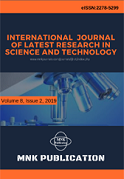DOI:10.29111/ijlrst ISRA Impact Factor:3.35, Peer-reviewed, Open-access Journal
Research Paper Open Access
International Journal of Latest Research in Science and Technology Vol.6 Issue 5, pp 33-39,Year 2017
Correspondence should be addressed to :
Received : 26 September 2017; Accepted : 06 October 2017 ; Published : 31 October 2017

| Download | 125 |
|---|---|
| View | 178 |
| Article No. | 10757 |
The aim of this study was to ascertain spatial inequality of diversity of hermatypic corals in north Langkawi, Peninsular Malaysia. Set in similar environmental settings, reef extent and reef conditions, coral taxonomy and species diversity were carried out on two fringing reefs, Teluk Datai and Teluk Dedap, located on opposite sides of the study area. The assumptions were firstly, the extent and morphology of the two reefs should be discriminatingly unequal, and secondly, both reefs should have high dissimilarity of diversity in terms of species compositions. Line Intercept Transect method was used to collect field data while Jaccard’s Index was used to compute level of similarity. Results showed there were 76 species of hard corals found in the much larger reefs in Teluk Datai comprising of 35 genera, 14 families and 4 sub-orders where dominant corals belonged to the families of Acroporidae, Faviidae and Poritidae. In Teluk Dedap, there were 37 hard coral species comprised of 4 sub-orders, 10 families, and 22 genera and dominant coral families belonged to Faviidae and Poritidae. Members of the Faviidae and Poritidae corals found in both reefs appeared to be the hardier ones with higher tolerance towards intermediate sediment load or more turbid waters. Jaccard's Index with a value of 73.04% of dissimilarity between the two fringing reefs showed that these reefs were quite diverse in its hermatypic coral compositions. The total coral area of Teluk Datai was 1,077,250 m2 while in Teluk Dedap was 63,000m2. The distributions of coral reefs do not necessarily reflect the limits of distribution of corals themselves. The number of coral species in Teluk Datai is twice of that found in Teluk Dedap. This study authenticated spatial inequality by proving both assumptions. It is not crucial to look at the extent of a reef but rather its richness or its diversity because in reef building process, it is the hardier species with the ability to tolerate and withstand physical and chemical environmental conditions that will eventually dominate.
Copyright © 2017 Anisah Lee Abdullah et al. This is an open access article distributed under the Creative Commons Attribution 4.0 International (CC BY 4.0) license which permits unrestricted use, distribution, and reproduction in any medium, provided the original work is properly cited.
Anisah Lee Abdullah , " Spatial Inequality: Evaluating Diversity Of Hermatypic Corals In Similar Reef Settings Of North Langkawi ", International Journal of Latest Research in Science and Technology . Vol. 6, Issue 5, pp 33-39 , 2017

MNK Publication was founded in 2012 to upholder revolutionary ideas that would advance the research and practice of business and management. Today, we comply with to advance fresh thinking in latest scientific fields where we think we can make a real difference and growth now also including medical and social care, education,management and engineering.

We offers several opportunities for partnership and tie-up with individual, corporate and organizational level. We are working on the open access platform. Editors, authors, readers, librarians and conference organizer can work together. We are giving open opportunities to all. Our team is always willing to work and collaborate to promote open access publication.

Our Journals provide one of the strongest International open access platform for research communities. Our conference proceeding services provide conference organizers a privileged platform for publishing extended conference papers as journal publications. It is deliberated to disseminate scientific research and to establish long term International collaborations and partnerships with academic communities and conference organizers.